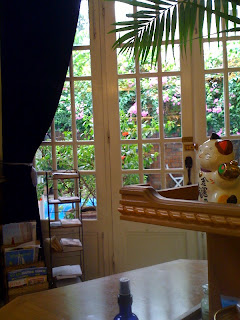If the guy on top gets electrocuted the guy lower down takes over. That’s the power back up system in Saigon.
For the past couple of months daytime temperatures have been hovering around 100 degrees here. Even the natives are complaining. When it’s this hot you want to be inside with the A/C on and the fans turning. Unfortunately, there isn’t enough power in Vietnam to go around so power in the industrial and hi-tech parks is usually only available 3 days a week. Most of those plants have their own aux generators so they can keep going. In the rest of the city the power authority does its best to keep it on, but every day some neighborhoods get taken off the grid to save the system from catastrophic failure. If you’re lucky you find out ahead of time. If not, the lights go out, the A/C goes off, and you grab your laptop and head for a coffee shop with wifi in another part of town. I’ve come to know that if the power fails before 10am it will be off most of the day.
I’m almost as fascinated by the wires and wire bundles of Saigon as I am by the mysterious rules that govern motorbike traffic. I’ve been told that it’s so difficult to figure out what the wires are actually hooked up to that the power company waits until they fall down – then they trace them back to the source. Take a look at this picture and multiply it by every intersection in a city of 8 – 10 million. It’s a miracle anyone can figure it out.
Yesterday the Seattle Times had an article entitled “Deadly shocks in Vietnam raise safety-rule concerns.” At least somebody is paying attention, but I guess when school kids start to die because there are live wires on school grounds or customers die because they touched an ungrounded ATM it starts to get noticed. Check it out:
http://seattletimes.nwsource.com/html/nationworld/2012094687_vietnamshocks12.html
It’s an exciting, some would say electrifying, place. Remember to wear your rubber soled shoes.



































